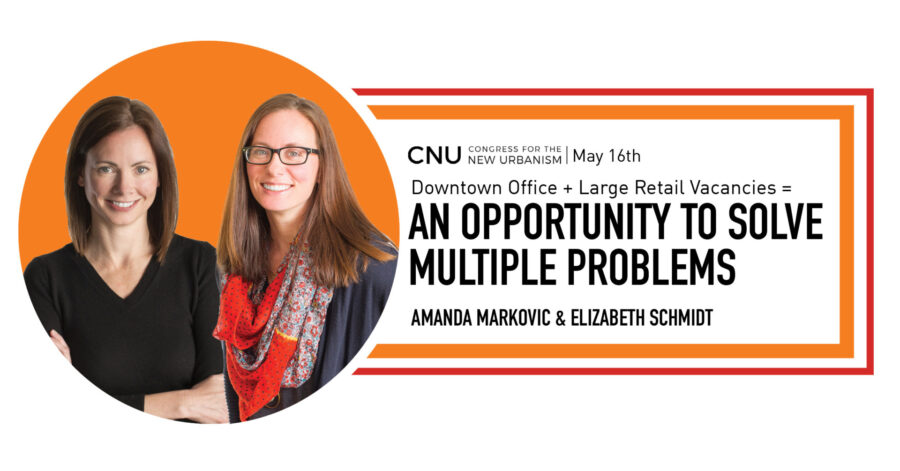Insights
Jul 17, 2024 _ insights
Reinventing the City One Building at a Time: Responding to Office & Large, Retail Vacancies
The urban core of most American cities used to be the center of all activity – housing, commerce, recreation. However, as suburbs expanded in the mid-twentieth century, their downtowns shifted to become almost exclusively a place to go to work. And today, the way we use downtown is changing again.
Over the past couple of decades—and more rapidly, with the rise of remote and hybrid work over the last four years—the city center is no longer exclusively a place to work. Offices are seeing fewer people return, which is having a ripple effect, reducing real estate values, tax revenue, and the vibrancy of our cities.
So, what do we do with the vacant offices and retail spaces that used to be so central to the function of our downtowns? We recently discussed this question at the Congress for the New Urbanism’s (CNU) 32nd Annual Conference. Here are some key takeaways:
- Adaptive reuse is an answer, but it’s not a straightforward issue. With high rates of office vacancies in the wake of the COVID-19, there’s a lot of interest in Office-to-Residential conversions right now. But not every building is suitable to be converted to residential.
- Adaptive reuse needs to be mindful of the state and potential of existing buildings. Two adaptive reuse projects we’ve recently worked on include large retail floorplates (a former Saks Fifth Avenue and a former Macy’s), but their deep floorplates would make them poor candidates for residential space. Among other issues, large swaths of the building would be unable to access natural light. That said, we were able to design satisfying ways to make these buildings operate as office and restaurant space.
- Creativity is a must, both in terms of design and funding. The fact is that many of the buildings that are ripe for repurposing require major investments. Our co-presenter, The Model Group, described their efforts to assemble financing for some large adaptive reuse projects, and they’re often drawing on 15+ funding sources. In addition to private capital, this frequently includes historic tax credits, new market tax credits, and other traditional sources as well as economic development funds from sources like Jobs Ohio.
While it’s unrealistic to simply wait for people to come back to the office, we can extend the life of vacant buildings in the urban core by finding new ways to use them. This is not only sustainable in terms of the building itself, but it offers a way of building more vibrant, walkable communities.
For more on this topic, see our presentation here.
For examples of GBBN’s adaptive reuse projects, in and outside of the urban core, see our case studies on the Foundry, City Club Apartments Union Central, the Roundhouse at Hazelwood Green, or Cincinnati & Hamilton County Public Library’s Deer Park Library
 Amanda Markovic is a principal and market design leader in GBBN’s Mixed-use market. AIA Pittsburgh’s Blueprint for Better Champion, Amanda is a frequent presenter at regional and national community design conferences. Her recent work includes Fifth & Dinwiddie West and East, Cincinnati & Hamilton County Public Library’s Deer Park Branch, and Roundhouse at Hazelwood Green.
Amanda Markovic is a principal and market design leader in GBBN’s Mixed-use market. AIA Pittsburgh’s Blueprint for Better Champion, Amanda is a frequent presenter at regional and national community design conferences. Her recent work includes Fifth & Dinwiddie West and East, Cincinnati & Hamilton County Public Library’s Deer Park Branch, and Roundhouse at Hazelwood Green.
 Elizabeth Schmidt is an associate in GBBN’s Mixed-use market. Elizabeth’s skill at collaboratively puzzling out design solutions is one of the many reasons project teams seek out her design acumen, creative thinking, and problem solving. She works diligently at both a team and individual level to create the best project possible. Her recent work includes City Club Apartments Union Central, Ronald McDonald House Charities Dayton’s New House, and Fifth & Dinwiddie West.
Elizabeth Schmidt is an associate in GBBN’s Mixed-use market. Elizabeth’s skill at collaboratively puzzling out design solutions is one of the many reasons project teams seek out her design acumen, creative thinking, and problem solving. She works diligently at both a team and individual level to create the best project possible. Her recent work includes City Club Apartments Union Central, Ronald McDonald House Charities Dayton’s New House, and Fifth & Dinwiddie West.




